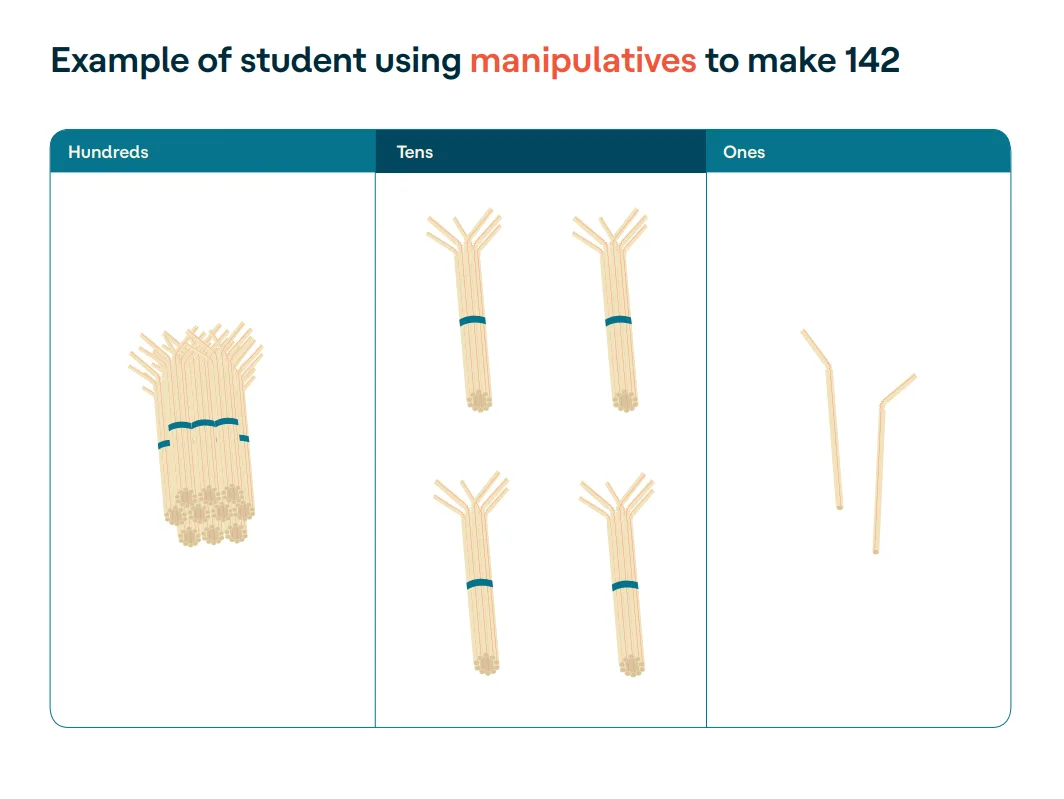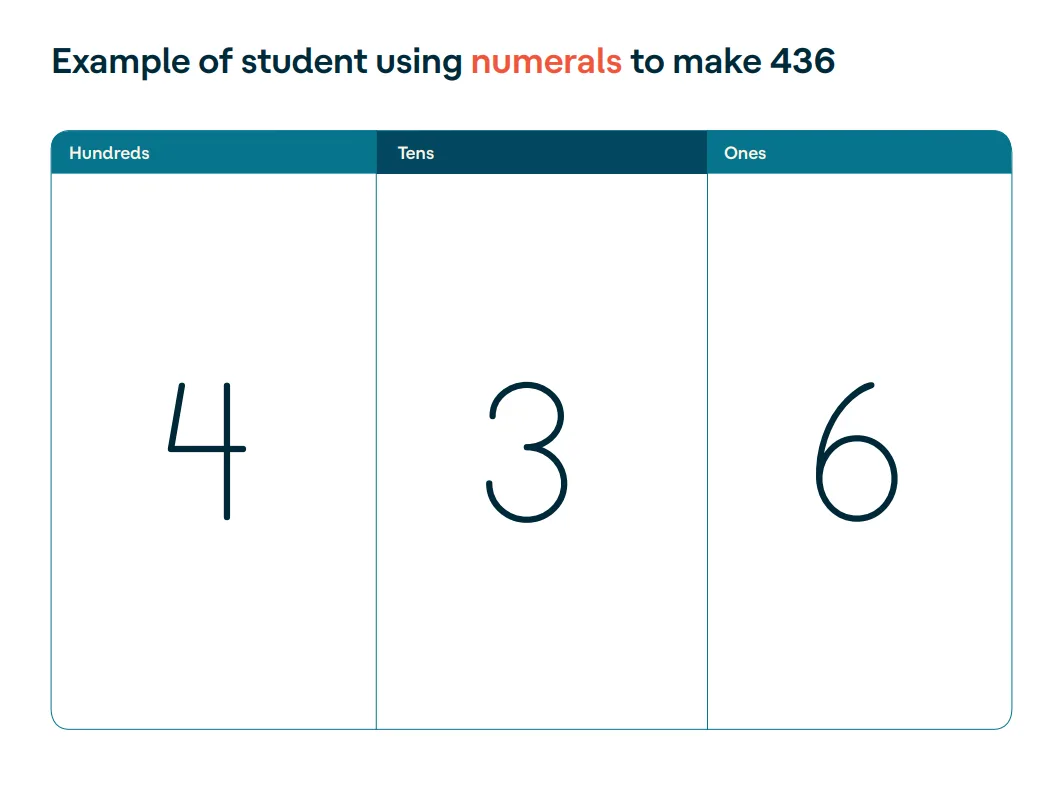Place value with straw bundles: An evidence-based math strategy

Place value is an important math concept for early elementary students to understand. They have to learn that the value of a digit depends on its place in a number. For example, students should understand that in the number 142, the digit 1 has a value of 1 hundred. The digit 4 has a value of 4 tens, and the digit 2 has a value of 2 ones. When students struggle to understand place value, it can hold them back in understanding more advanced math concepts.
One way to help students understand place value is to use manipulatives to show the value of each digit. You can do this using straws (or wooden craft sticks) and a place value mat. With this strategy, you use the manipulatives to explicitly teach students how to compose a number. Using the straws, they will create a multi-digit number by showing the value of each digit separately. This helps students make the connection between numbers and place values.
Watch: Using bundles to teach place value
Watch this video to learn how to teach students to bundle straws or wooden craft sticks.
Download: Printable place value mat
Print this place value mat or teach students to draw their own.
Place value mat - hundredsPDF - 25.1 KB
Read: How to use this place value strategy
Objective: Students will compose two-digit (for first grade) or three-digit (for second grade) numbers and explain the place value of each digit.
Grade levels (with standards):
1 (Common Core 1.NBT.B.2: Understand that the two digits of a two-digit number represent amounts of tens and ones)
2 (Common Core 2.NBT.A.1: Understand that the three digits of a three-digit number represent amounts of hundreds, tens, and ones)
1–2 (Common Core Math Practice MP2: Reason abstractly and quantitatively; Common Core Math Practice MP5: Use appropriate tools strategically)
Best used for instruction with:
Whole class
Small groups
Individuals
How to prepare:
Gather materials. Give each student straws (or wooden craft sticks), elastic bands, and the printable place value mat. Putting elastic bands around straws or sticks can be tricky for students who struggle with fine motor skills. You can offer your students options for what objects they want to bundle and how they want to bundle them, like putting 10 crayons in a small snack bag or 10 sticks in a small cup to form a bundle.
How to teach:
1. Practice making bundles. Explain to students that they’ll be using straws to help understand place value. They will count individual straws as “ones” and bundle straws together in groups of 10 as “tens.” (In second grade, they’ll also bundle together 10 groups of tens to make “hundreds.”) Explicitly review the academic vocabulary needed for the lesson like tens, ones, place, and value.
For English language learners (ELLs): Identify words that have more than one meaning, like place. Using pictures or other supports, share the definitions of the word. For example, place could mean a physical spot, like a park. Or if a friend says “save me a place at lunch,” they are asking for you to have a spot for them at the table. Make the connection that the place in place value is a spot in the number.
Model how to count 10 straws. Count them out loud and then secure them together with a rubber band to make 1 group of ten. Show that 10 ones equal 1 ten.
Then have students do the same. Prompt them to count out 10 straws and then bundle the 10 straws together to make 1 ten. Then, repeat with another 10 ones to make a second bundle of tens. If students have straws left over, have them count those straws as “ones” that can’t be bundled. (For second grade, continue until students can count the bundles of tens to make 1 hundred.)
You can also offer the opportunity to all students to watch a student-friendly video about bundling.
2. Compose the number using concrete manipulatives. Tell students they will use the straws and a place value mat to compose (or “make”) a number. Follow the concrete-representational-abstract (CRA) sequence of instruction, starting with the concrete. Begin by looking at the place value mat and explaining each column: hundreds, tens, and ones. Model how to use the straws on the place value mat. For instance, you can make the number 24 for first graders by putting 2 bundles of 10 in the tens column and 4 ones in the ones column. For second graders, you can compose the number 142 by stacking 10 bundles of 10 in the hundreds column and placing 4 bundles of 10 in the tens column and 2 ones in the ones column.

For ELLs: Provide additional support by using sentence frames. For example, for the number 24 you can write on the board and have students fill in the blanks: "The number is 24. There are two tens in 24. There are four ones in 24." This visual support is especially important for numbers that sound alike, such as 17 and 70.
Allow students to practice doing the same with several numbers. Give them feedback as they work. Ask students to share their thinking with their classmates after composing each number. For example, you might have students turn and talk to share what they placed in each column for the number 24.
3. Move to the representational. After students know how to compose numbers using concrete materials, move on to the representational level of understanding. Model how to draw bundles on the place mat. To represent the number 16, draw 10 vertical lines with a circle around them or a slash line through them in the tens column and 6 vertical lines in the ones column. Then, represent the same number with rougher sketches of bundles to show students that they don’t need to draw all the lines in a tens (or hundreds) bundle. Talk about how although you can’t see all 10 lines in your rougher sketch, you know to count it as 10 because it’s bundled with a circle or a slash line.
Then, have students draw bundles in the appropriate columns on their own place value mats to make a number. For example, first graders can compose the number 53 by drawing 5 bundles of 10 in the tens column and 3 ones in the ones column. In second grade, students can compose the number 253 using similar drawings. Again, provide plenty of opportunities for practice and feedback. Invite students to explain their drawings and say the standard number.

Teaching tip: To reuse the place value mats throughout the lesson, put the mats inside dry-erase pockets and have students use dry-erase markers that can be wiped clean before moving on to the next example.
4. End with the abstract. After mastering the representational level, move on to the abstract level. On a place value mat, have students compose a number using only written numbers — like 6 tens and 7 ones make “67” or, for second grade, 4 hundreds, 3 tens, and 6 ones make “436.” Provide sentence frames on the board with fill-in-the-blanks for visual support: "six tens and seven ones makes 67." To encourage flexibility, you can try moving places out of order. For instance, explain that a number has 7 ones and 3 tens and have students show 37.
If students struggle at the abstract level, allow them to go back to using bundles and then pictures. Emphasize the connection between the bundled objects, the representational pictures, and the numerical symbols. Move on to the abstract level once students demonstrate understanding.

Teaching tip: You can continue to practice place value by finding real-world numbers all around your students. During lessons in other subjects, point to numbers you see, like numbered pages in a picture book or a street address on an envelope. Challenge students to make the numbers by place value. You can also challenge students to find two- or three-digit numbers in their own lives and bring those examples back to class for practice.
Understand: Why this strategy works
Some students struggle to make a connection between our base 10 number system and the language we use for numbers. That’s because the language we use for numbers doesn’t directly translate. For example, we write “216,” not “200 10 6.”
Composing numbers using this strategy will help students make the connection between the number system and language. It shows them that a number is made up of the sum of its parts.
Also, students benefit from the use of multiple models, including straw bundles, place value disks, and drawings. Students also learn from support and feedback as they move from concrete to abstract representations of a number.
Improving students’ understanding of place value lays the foundation for future math work, including addition with regrouping in second grade, and multiplication, fractions, and decimals in upper elementary grades.
Connect: Link school to home
Share with families that students are learning about place value in school. It may be different from how family members learned math when they were younger. That’s because math is taught differently today.
Send home resources to help families reinforce the concept of place value. By email, you can share an article that explains how to use multisensory techniques for place value and other math concepts and a video about what second graders learn about place value.
You might also share the following video with families to help them understand how their children are learning to compose and decompose numbers.






